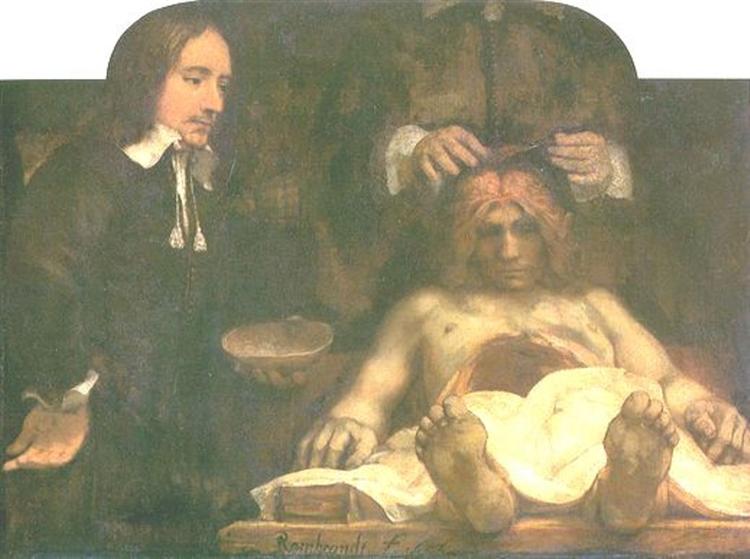Description
The painting "Anatomy of Doctor Deyman", created by Rembrandt in 1656, is a work that falls into the genre of group portraiture, a field in which the Dutch master achieved unparalleled mastery. This work, which represents an anatomy lesson, not only reflects Rembrandt's technical skill, but also his ability to infuse humanity and drama into the seemingly scientific subjects he addressed.
The painting depicts Dr. Jan Deyman, a real-life anatomist, presenting the body of a deceased person to a group of physicians and students, illustrating the practice of anatomy at a time when the study of the human body was in full swing. The central figure, Dr. Deyman, is characterized by his dynamic and authoritative posture, standing erect in front of the operating table. The attentiveness of the attendants, their concentrated faces often reflecting a mixture of curiosity and reverence, underlines the educational and ritual context surrounding these sessions.
The composition of the work is remarkably asymmetrical, something Rembrandt handles masterfully. It is arranged in such a way that viewers are effectively drawn into the action, anchoring their gaze on the exposed body, which contrasts with the dark, rich clothing of the doctors. The use of chiaroscuro, a technique Rembrandt masterfully manipulated, creates a sense of depth and volume in the figures, enhancing the three-dimensionality and providing a visual drama that captures the meaning of the scene.
The colours that dominate the work are earthy, with a predominance of browns, ochres and blacks, which can emotionally connect with the viewer by evoking a sense of gravity and solemnity. The white colour of the exposed body not only highlights its central role in the narrative, but also acts as a symbol of the fragility of life and inevitable death, recurring themes in Rembrandt's work.
As far as the characters are concerned, each figure presents a carefully constructed individuality, although the direct focus of the painting is on Doctor Deyman and his task. The attention to detail in the facial representation and clothing of each figure indicates Rembrandt's intention not only to present an academic scene, but to tell a story of the medical character in his context, bringing to life a scene that could have been merely documentary.
The work is in line with other works of the period that also explore themes of anatomy and science, although often from a colder and more objective perspective. Rembrandt, in contrast, brings a personal and emotional touch that transforms the act of dissection into a meditation on life, death and the responsibility of science towards humanity.
"The Anatomy of Doctor Deyman" stands as a testament to Rembrandt's genius, not only in his ability to capture the human essence, but also in his approach to light, color and form. This painting is, in its complexity, a moment in art history that transcends its immediate context, inviting viewers to engage in a deeper reflection on the interplay between art, science and the ephemeral nature of life.
KUADROS ©, a famous painting on your wall.
Hand-made oil painting reproductions, with the quality of professional artists and the distinctive seal of KUADROS ©.
Painting reproduction service with satisfaction guarantee. If you are not completely satisfied with the replica of your painting, we will refund 100% of your money.

